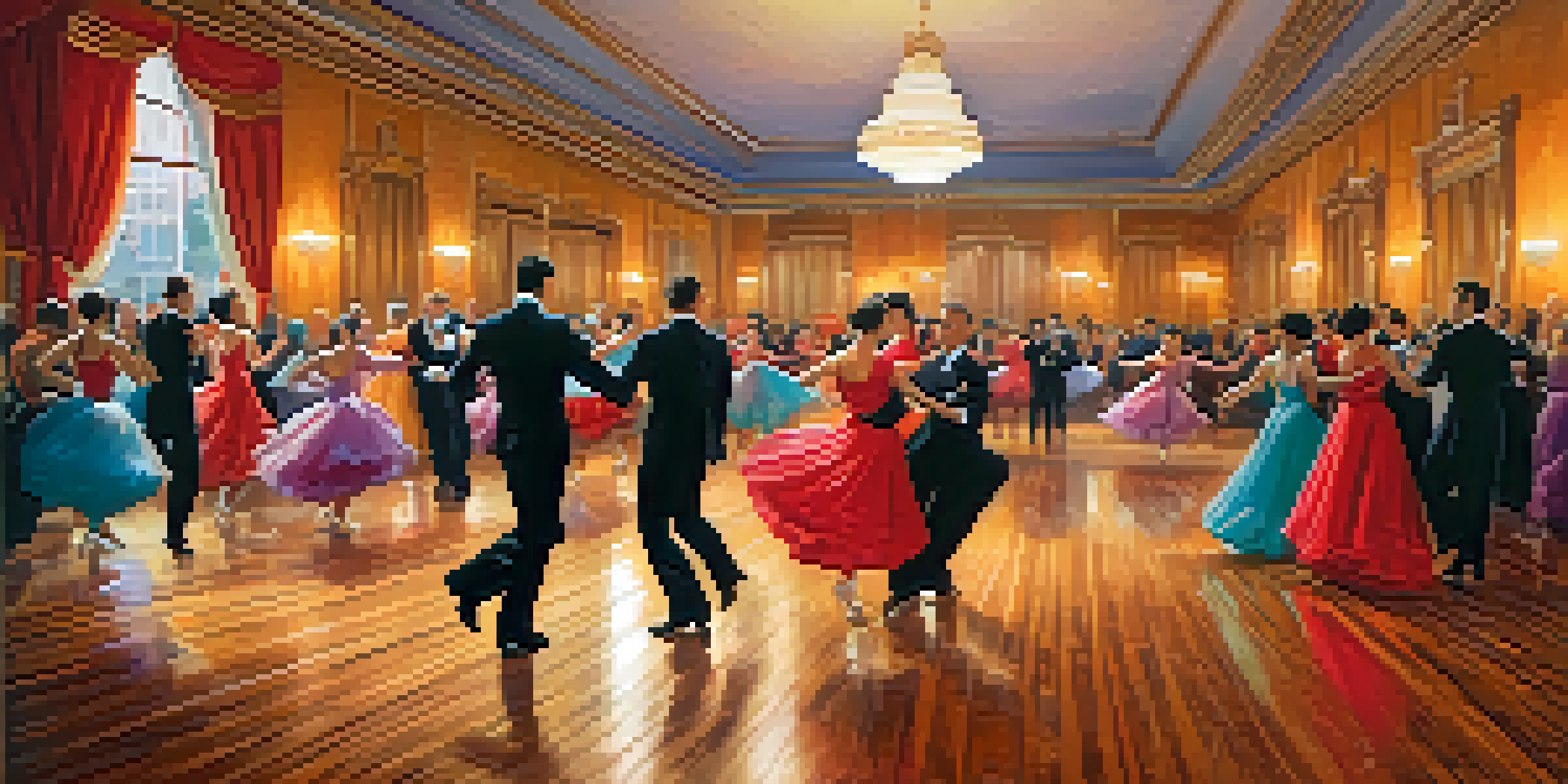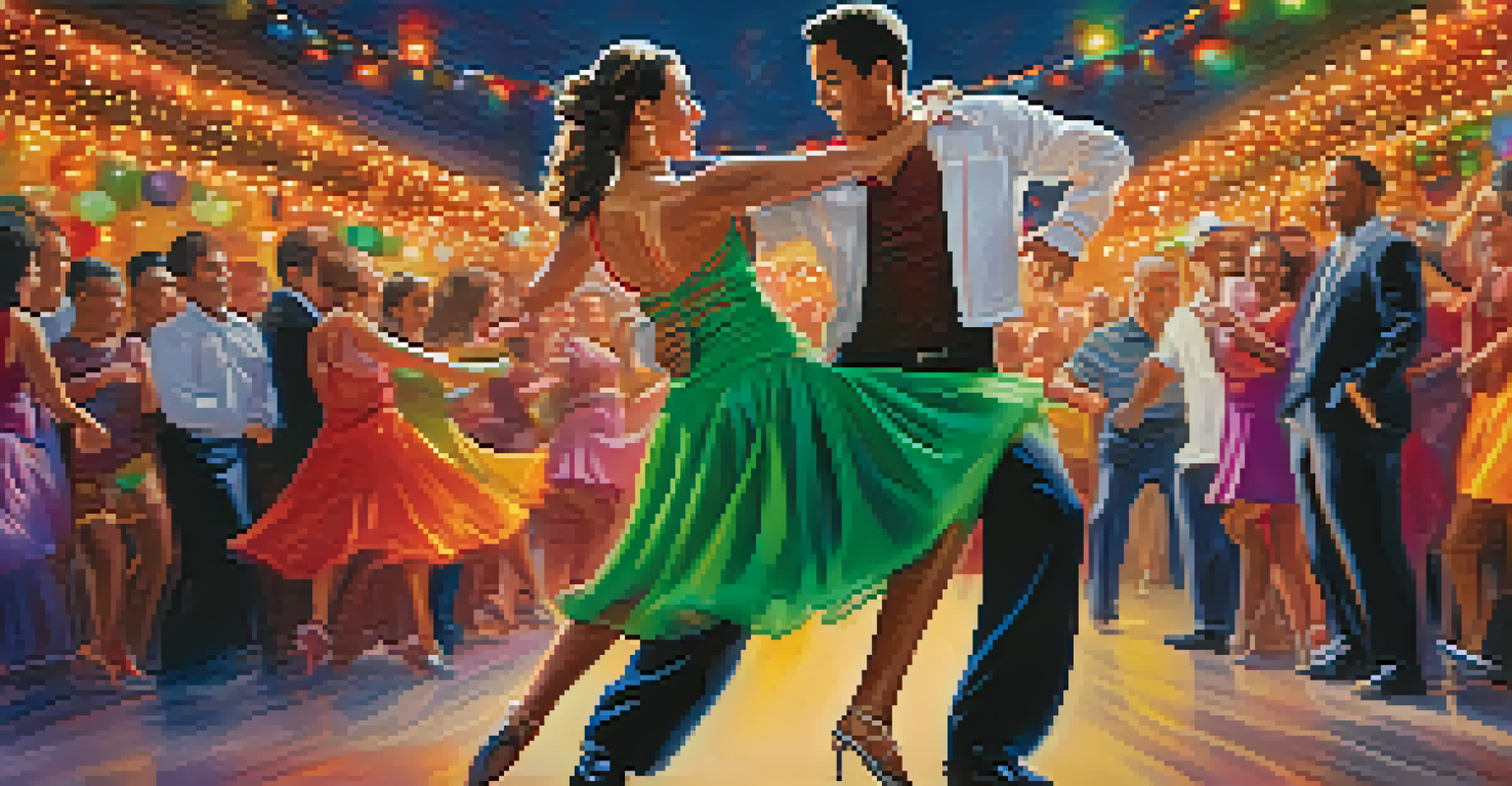How Social Dance Improves Memory and Cognitive Function

The Link Between Dance and Brain Health
Social dance is more than just an enjoyable pastime; it has profound effects on brain health. Engaging in dance requires the coordination of various cognitive skills, such as memory, attention, and spatial awareness. These activities stimulate different areas of the brain, promoting neuroplasticity, which is the brain's ability to reorganize itself by forming new neural connections. Essentially, every step you take on the dance floor is a workout for your brain, enhancing its overall function.
Dance is the hidden language of the soul.
When you learn new dance routines, you’re not just moving your body; you’re also training your mind to remember sequences and patterns. This mental exercise translates to improved memory and cognitive function in everyday life. Think of it as a fun way to give your brain a boost while enjoying the rhythm of music and the company of others.
Moreover, social dance provides a unique combination of physical activity, social interaction, and mental challenge, making it an ideal way to support brain health. With regular participation, dancers often experience sharper memory and quicker cognitive responses, showcasing the powerful connection between movement and mental agility.
How Dance Involves Learning and Memory
Learning to dance involves memorizing steps, sequences, and even the nuances of rhythm. This process exercises your memory by necessitating recall and practice, similar to studying for an exam. Each time you practice a new routine, you're strengthening the neural pathways associated with those movements, which enhances your overall memory capacity.

Furthermore, social dance often incorporates improvisation, requiring dancers to think on their feet. This kind of spontaneous decision-making can sharpen cognitive function, as it compels the brain to adapt and respond to new situations. For instance, a dancer might need to adjust their movements in response to a partner's cues, which fosters quick thinking and adaptability.
Dance Boosts Brain Health
Engaging in social dance stimulates cognitive skills and promotes neuroplasticity, enhancing overall brain function.
The memory skills honed through dance can also spill over into daily life. Regular dancers often find that their ability to remember names, faces, and tasks improves, reflecting the benefits of their dance practice on general memory retention.
Social Interaction: A Cognitive Booster
One of the most compelling aspects of social dance is its emphasis on interaction. Dancing with others creates a sense of community and belonging, which can significantly enhance mental well-being. Engaging socially stimulates the brain and decreases stress levels, both of which are crucial for cognitive health.
The body says what words cannot.
When you dance with a partner or in a group, you’re not only working on your moves but also developing communication skills and emotional intelligence. These interactions require you to read your partner’s body language and respond accordingly, fostering an environment where cognitive skills can thrive. It’s like a dance-off for your brain, keeping it sharp and engaged.
Additionally, the joy and laughter shared on the dance floor can release endorphins, further boosting your mood and cognitive function. This blend of social engagement and physical activity creates an enriching environment that promotes brain health in a delightful way.
The Benefits of Rhythm and Coordination
Dance is fundamentally about rhythm and coordination, both of which play critical roles in cognitive function. When you dance, your brain processes the music and coordinates your movements in time, which enhances timing and motor skills. This synchronization sharpens your cognitive abilities and can even improve your timing in daily activities.
Moreover, practicing various styles of dance introduces different rhythms and tempos, challenging your brain to adapt continuously. For example, switching from a slow waltz to a fast-paced salsa requires quick adjustments in both movement and thought, encouraging your brain to stay agile and responsive.
Social Interaction Enhances Cognition
Dancing with others fosters communication skills and emotional intelligence, providing a cognitive boost through social engagement.
These rhythmic challenges can also foster better auditory processing skills, as dancers learn to interpret and react to music in real-time. This not only enhances coordination but also boosts overall cognitive function, making rhythm and coordination key components of the dance experience.
Physical Exercise: Fuel for the Brain
It’s well-known that physical exercise is vital for overall health, but its impact on cognitive function is equally significant. Social dance provides a fun and engaging way to get your heart rate up while simultaneously stimulating your brain. This combination of physical and mental activity is a recipe for improved memory and cognitive performance.
When you dance, your body releases endorphins and other chemicals that promote brain health, such as BDNF (brain-derived neurotrophic factor). BDNF plays a key role in supporting the survival of existing neurons and encouraging the growth of new ones, which is essential for learning and memory.
Furthermore, regular physical activity through dance can help prevent cognitive decline as you age. Studies suggest that those who engage in dance have a lower risk of dementia and other cognitive disorders, highlighting the protective benefits of this enjoyable exercise.
Mindfulness and Presence in Dance
Social dance encourages mindfulness, as dancers must be present in the moment to connect with their partners and the music. This focus on the here and now can greatly enhance cognitive function by reducing distractions and improving attention. When you fully immerse yourself in dance, you're exercising your brain in a way that promotes clarity and concentration.
This mindfulness aspect also allows dancers to better manage stress and anxiety, which can negatively impact memory and cognitive abilities. By focusing on the rhythm and movement, dancers often find a respite from daily worries, creating a mental space conducive to better cognitive function.
Physical Movement Fuels Learning
The combination of physical exercise and mental challenges in dance supports memory retention and cognitive agility.
Incorporating mindfulness through dance can lead to improved overall well-being, allowing your brain to function at its best. It’s like a reset button for your mind, helping you feel more alert and engaged in all aspects of life.
Conclusion: Dance Your Way to a Sharper Mind
Social dance presents a unique opportunity to enhance memory and cognitive function while enjoying the rhythmic embrace of music and movement. The combination of physical exercise, social interaction, and cognitive challenges creates a powerful formula for brain health. Whether you’re twirling at a ballroom class or grooving at a salsa night, every dance step is a step toward a sharper mind.
Moreover, the benefits of dance extend beyond the dance floor, improving your daily life through better memory retention and cognitive agility. By incorporating social dance into your routine, you’re not just having fun; you’re also investing in your brain’s future.

So lace up your dancing shoes and let the music guide you. Each dance is a delightful way to nurture your mind and body, proving that sometimes the best way to boost cognitive function is to get up and move!